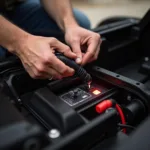Dealing with unsightly scratches and chips on your car’s paint? While frustrating, small paint repair is often a quick and affordable fix. Whether it’s a minor door ding or a scratch from a runaway shopping cart, understanding your options for small paint repair can save you time, money, and unnecessary headaches.
Assessing the Damage: When is a Small Paint Repair Feasible?
Before diving into repair options, it’s crucial to assess the severity of the damage. Small paint repair is generally suitable for:
- Scratches: Light scratches that haven’t penetrated the primer layer can often be buffed out or touched up with paint.
- Chips: Small paint chips, like those from rocks, can be repaired with touch-up paint and a steady hand.
- Scuffs: Minor scuffs that haven’t removed much paint can often be polished away.
However, larger areas of damage, deep scratches exposing bare metal, or dents that require bodywork will necessitate more extensive repairs at a professional body shop.
DIY Small Car Paint Repair: A Cost-Effective Solution for Minor Damage
For those comfortable with a bit of hands-on work, DIY small car paint repair can be a budget-friendly option. Here’s a step-by-step guide:
- Clean the Area: Thoroughly wash and dry the damaged area to remove dirt, wax, or debris.
- Sand (If Necessary): For scratches that haven’t penetrated the primer, use fine-grit sandpaper (2000-grit or higher) to smooth the edges.
- Apply Touch-Up Paint: Using a fine-tipped brush or a touch-up pen, carefully apply thin layers of matching touch-up paint to the damaged area. Allow each layer to dry completely before applying the next.
- Level the Surface: Once the paint is dry, use fine-grit sandpaper (2000-grit or higher) soaked in soapy water to level the repaired area with the surrounding paint.
- Polish and Protect: Use a rubbing compound and a polishing pad to blend the repaired area and restore shine. Finish with a coat of car wax for protection.
Remember, patience and precision are key to achieving a seamless finish. If you’re unsure about any step or uncomfortable with DIY repair, consult a professional.
Professional Small Paint Repair: When to Seek Expert Help
While DIY can be effective for minor damage, professional small paint repair offers distinct advantages, especially for:
- Deep Scratches and Chips: Experts have the tools and expertise to repair damage that extends to the primer or metal.
- Color Matching: Professionals use advanced techniques to ensure a perfect color match, especially for cars with complex or pearlescent paint finishes.
- Seamless Finish: Professional repairs leave your car looking its best, with a smooth and polished finish that’s hard to distinguish from the original paint.
“When it comes to preserving your car’s value, professional paint repair, even for small imperfections, is a worthwhile investment,” advises John Smith, Senior Automotive Technician at ABC Auto. “A quality repair not only enhances aesthetics but also protects against rust and further damage.”
Factors Affecting Small Car Paint Repair Cost
The cost of small car paint repair can vary based on:
- Severity of Damage: Deeper scratches and larger areas of damage require more time and materials.
- Type of Repair: Touch-up paint applications are generally less expensive than blending techniques.
- Location: Labor rates and material costs can differ depending on your geographical location.
- Shop Reputation: Reputable shops with experienced technicians may charge more, but they often deliver higher quality results.
Small Car Paint Repair: Maintaining Your Car’s Appearance and Value
Small paint repair is an essential aspect of car maintenance, helping to preserve your vehicle’s appearance, protect its value, and prevent further damage. Whether you opt for DIY solutions or seek professional help, addressing paint imperfections promptly can save you time, money, and frustration in the long run.
FAQs About Small Paint Repair on Cars
Q: Can I use nail polish for small car paint repair?
A: While tempting for a quick fix, nail polish isn’t formulated for automotive paint and can cause further damage.
Q: How long does touch-up paint take to dry?
A: Drying time varies depending on the type of touch-up paint and environmental conditions, but it’s generally best to allow at least 24 hours for complete drying.
Q: Can I wax over touch-up paint?
A: Yes, you can wax over touch-up paint once it’s completely dry, typically after 24-48 hours.
Q: How can I prevent small paint damage to my car?
A: Regular washing, waxing, and parking in covered areas can help minimize the risk of small paint damage.
Q: When should I contact my insurance company about car paint damage?
A: It’s best to consult your insurance policy and agent to understand your coverage for paint damage.
Need help with a small car paint repair? Contact us via WhatsApp: +1(641)206-8880, or Email: [email protected]. Our team is available 24/7 to assist you. For more information on small car paint repair, you can read our comprehensive guide. If you’re interested in finding out how much to repair a small paint scratch on a car, check out our detailed article on the topic. You can also find valuable insights into small car paint repair costs.



